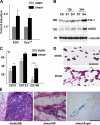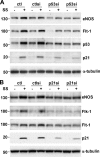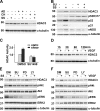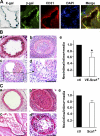HDAC3 is crucial in shear- and VEGF-induced stem cell differentiation toward endothelial cells
- PMID: 16982804
- PMCID: PMC2064396
- DOI: 10.1083/jcb.200605113
HDAC3 is crucial in shear- and VEGF-induced stem cell differentiation toward endothelial cells
Abstract
Reendothelialization involves endothelial progenitor cell (EPC) homing, proliferation, and differentiation, which may be influenced by fluid shear stress and local flow pattern. This study aims to elucidate the role of laminar flow on embryonic stem (ES) cell differentiation and the underlying mechanism. We demonstrated that laminar flow enhanced ES cell-derived progenitor cell proliferation and differentiation into endothelial cells (ECs). Laminar flow stabilized and activated histone deacetylase 3 (HDAC3) through the Flk-1-PI3K-Akt pathway, which in turn deacetylated p53, leading to p21 activation. A similar signal pathway was detected in vascular endothelial growth factor-induced EC differentiation. HDAC3 and p21 were detected in blood vessels during embryogenesis. Local transfer of ES cell-derived EPC incorporated into injured femoral artery and reduced neointima formation in a mouse model. These data suggest that shear stress is a key regulator for stem cell differentiation into EC, especially in EPC differentiation, which can be used for vascular repair, and that the Flk-1-PI3K-Akt-HDAC3-p53-p21 pathway is crucial in such a process.
Figures








Similar articles
-
Sca-1+ progenitors derived from embryonic stem cells differentiate into endothelial cells capable of vascular repair after arterial injury.Arterioscler Thromb Vasc Biol. 2006 Oct;26(10):2244-51. doi: 10.1161/01.ATV.0000240251.50215.50. Epub 2006 Aug 10. Arterioscler Thromb Vasc Biol. 2006. PMID: 16902164
-
Epigenetic histone modification and cardiovascular lineage programming in mouse embryonic stem cells exposed to laminar shear stress.Circ Res. 2005 Mar 18;96(5):501-8. doi: 10.1161/01.RES.0000159181.06379.63. Epub 2005 Feb 10. Circ Res. 2005. PMID: 15705964
-
Association of SIRT1 expression with shear stress induced endothelial progenitor cell differentiation.J Cell Biochem. 2012 Dec;113(12):3663-71. doi: 10.1002/jcb.24239. J Cell Biochem. 2012. PMID: 22740055
-
Role of histone deacetylases in vascular cell homeostasis and arteriosclerosis.Cardiovasc Res. 2011 Jun 1;90(3):413-20. doi: 10.1093/cvr/cvr003. Epub 2011 Jan 13. Cardiovasc Res. 2011. PMID: 21233251 Review.
-
Engineering blood vessels from stem cells: recent advances and applications.Curr Opin Biotechnol. 2005 Oct;16(5):516-23. doi: 10.1016/j.copbio.2005.08.007. Curr Opin Biotechnol. 2005. PMID: 16144762 Review.
Cited by
-
Endothelial cells derived from nuclear reprogramming.Circ Res. 2012 Oct 26;111(10):1363-75. doi: 10.1161/CIRCRESAHA.111.247213. Circ Res. 2012. PMID: 23104878 Free PMC article. Review.
-
Histone deacetylases and cardiovascular cell lineage commitment.World J Stem Cells. 2015 Jun 26;7(5):852-8. doi: 10.4252/wjsc.v7.i5.852. World J Stem Cells. 2015. PMID: 26131315 Free PMC article. Review.
-
Role of histone deacetylases in transcription factor regulation and cell cycle modulation in endothelial cells in response to disturbed flow.Proc Natl Acad Sci U S A. 2012 Feb 7;109(6):1967-72. doi: 10.1073/pnas.1121214109. Epub 2012 Jan 23. Proc Natl Acad Sci U S A. 2012. PMID: 22308472 Free PMC article.
-
Matrix stiffening promotes chondrocyte senescence and the osteoarthritis development through downregulating HDAC3.Bone Res. 2024 May 24;12(1):32. doi: 10.1038/s41413-024-00333-9. Bone Res. 2024. PMID: 38789434 Free PMC article.
-
YAP/TAZ deficiency reprograms macrophage phenotype and improves infarct healing and cardiac function after myocardial infarction.PLoS Biol. 2020 Dec 2;18(12):e3000941. doi: 10.1371/journal.pbio.3000941. eCollection 2020 Dec. PLoS Biol. 2020. PMID: 33264286 Free PMC article.
References
-
- Akimoto, S., M. Mitsumata, T. Sasaguri, and Y. Yoshida. 2000. Laminar shear stress inhibits vascular endothelial cell proliferation by inducing cyclin-dependent kinase inhibitor p21(Sdi1/Cip1/Waf1). Circ. Res. 86:185–190. - PubMed
-
- Bruhl, T., C. Heeschen, A. Aicher, A.S. Jadidi, J. Haendeler, J. Hoffmann, M.D. Schneider, A.M. Zeiher, S. Dimmeler, and L. Rossig. 2004. p21Cip1 levels differentially regulate turnover of mature endothelial cells, endothelial progenitor cells, and in vivo neovascularization. Circ. Res. 94:686–692. - PubMed
-
- Claesson-Welsh, L. 2003. Signal transduction by vascular endothelial growth factor receptors. Biochem. Soc. Trans. 31:20–24. - PubMed
-
- Coultas, L., K. Chawengsaksophak, and J. Rossant. 2005. Endothelial cells and VEGF in vascular development. Nature. 438:937–945. - PubMed
Publication types
MeSH terms
Substances
LinkOut - more resources
Full Text Sources
Other Literature Sources
Medical
Molecular Biology Databases
Research Materials
Miscellaneous

